Tram
 |
| Rail transport |
|---|
| Operations |
| Track |
| Maintenance |
| High-speed |
| Gauge |
| Stations |
| Trains |
| Locomotives |
| Rolling stock |
| Railways |
| History |
| Attractions |
| Terminology |
| By country |
| Accidents |
|
|
A tram, tramcar (British English), streetcar or trolley car (American English) is a railborne vehicle which - at least in parts of its route - runs on tracks in streets. It may also run between cities and/or towns (interurbans, Tram-train), and/or partially grade separated even in the cities (light rail or light rapid transit). Trams are usually lighter and shorter than conventional trains and rapid transit trains. However, the differences between these modes of public transportation are blurring. Some trams (for instance Tram-Trains) may also run on ordinary railway tracks, a tramway may be upgraded to a light rail or a rapid transit line, two urban tramways may be united to an interurban, etc. Trams are designed for the transport of passengers and (very occasionally) freight.
Most trams today use electrical power, usually fed by a pantograph; in some cases by a third rail. If necessary, they may have several power systems. Certain types of cable car are also known as trams. Another power sources is diesel; a few trams use electricity in the streets and diesel in more rural environments. Also steam and petrol (gas) have been used. Horse and mule driven trams do still occur.
The Silesian Interurbans in Poland and the Trams in Melbourne, Australia are claimed to be the largest tram networks in the world. Before its decline the BVG in Berlin operated a very large network with 634 km of route. During a while in the 1980s the world's largest tram system was in Leningrad, USSR, being included in Guinness World Records. The largest single tram line in the world is the Belgian Coast tram, whichs runs the entire length of the Belgian coast. Other large systems include Prague, Amsterdam, Basel, Zurich and Toronto. Until the system started to be converted to trolleybus (and later bus) in the 1930s, the first-generation London network was also one of the world's largest, with 526 km (327 mi) of route in 1934.[1] While the largest streetcar network in the world used to be located in Chicago, with over 850 km (530 miles) of track[2], all of which was converted to bus service by the late 1950s.
Tramways with tramcars (British English) or street railways with streetcars (American English) were common throughout the industrialised world in the late 19th and early 20th centuries but they had disappeared from most British, Canadian, French and U.S. cities by the mid-20th century.[3]
By contrast, trams in parts of continental Europe continued to be used by many cities, although there were contractions in some countries, including the Netherlands.[4]
Since 1980 trams have returned to favour in many places, partly because their tendency to dominate the highway, formerly seen as a disadvantage, is now considered to be a merit. New systems have been built in the United States, Great Britain, Ireland, France and many other countries.
Tramways are now included in the wider term "light rail", which also includes segregated systems. Some systems have both segregated and street-running sections, but are usually then referred to as trams, because it is the equipment for street-running which tends to be the decisive factor. Vehicles on wholly segregated light rail systems are generally called trains, although cases have been known of "trains" built for a segregated system being sold on to new owners and becoming "trams".

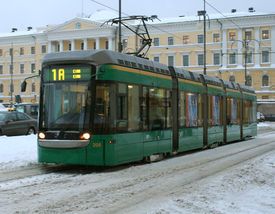
Etymology and terminology

The terms tram and tramway were originally (ca. 1500) Scottish words for the type of truck used in coal mines and the tracks on which they ran, probably derived from Middle Flemish tram "beam, handle of a barrow, bar, rung", a North Sea Germanic word of unknown origin meaning the beam or shaft of a barrow or sledge, also the barrow itself. Tram-car is attested from 1873.[5]
Although tram and tramway have been adopted by many languages, they are not used universally in English, North Americans preferring trolley, trolleycar or streetcar. The term streetcar is first recorded in 1840. When electrification came, Americans began to speak of trolleycars or later, trolleys, believed to derive from the troller, a four-wheeled device that was dragged along dual overhead wires by a cable that connected the troller to the top of the car and collected electrical power from the overhead wires, sometimes simply strung, sometimes on a catenary.[6] The trolley pole, which supplanted the troller early on, is fitted to the top of the car and is spring-loaded in order to keep the trolley wheel or skate, at the top of the pole, firmly in contact with the overhead wire. The terms trolley pole and trolley wheel both derive from the troller.[7] Trams are generally powered through a single trolley wheel and pole, grounded through the wheels and rails. The motor circuit is designed to allow electrical current to flow through the underframe.
Although this use of "trolley" for tram was not adopted in Europe, the term did appear with "trolleybus": a rubber tyred vehicle without tracks which draws its power from overhead wires.
Modern trolleys often use a metal shoe with a carbon insert instead of a trolley wheel, or have a pantograph. In North America, trams are sometimes called trolleys, even though strictly this may be incorrect: for example, cable cars, or conduit cars that draw power from an underground supply.
Tourist buses made to look like streetcars are sometimes called trolleys in the U.S. (tourist trolley). Open, low-speed segmented vehicles on rubber tires, generally used to ferry tourists short distances, can be called trams, for example on the Universal Studios backlot tour.
Electric buses, which use twin trolley poles (one for live current, one for return) but have wheels with tyres rolling on a hard surface rather than tracks, are called trolleybuses, trackless trolleys (particularly in the U.S.), or sometimes (in the UK) simply trolleys.
History

The very first tram was on the Swansea and Mumbles Railway in south Wales, UK; it was horse-drawn at first, and later moved by steam and electric power. The Mumbles Railway Act was passed by the British Parliament in 1804, and the first passenger railway (similar to streetcars in the US some 30 years later) started operating in 1807.[8] The first streetcars, also known as horsecars in North America, were built in the United States and developed from city stagecoach lines and omnibus lines that picked up and dropped off passengers on a regular route without the need to be pre-hired. These trams were an animal railway, usually using teams of horses and sometimes mules to haul the cars, usually two as a team. Occasionally other animals were put to use, or humans in emergencies. The first streetcar line, developed by Irish-American John Stephenson, was the New York and Harlem Railroad's Fourth Avenue Line which ran along the Bowery and Fourth Avenue in New York City. Service began in 1832.[9] It was followed in 1835 by New Orleans, Louisiana, which has the oldest continuously operating street railway system in the world, according to the American Society of Mechanical Engineers.[10]
In 1883, Magnus Volk constructed his 2-ft gauge Volk's Electric Railway along the eastern seafront at Brighton, England. This 2-km line, re-gauged to 2 ft 9ins in 1884, remains in service to this day, and is the oldest operating electric tramway in the world. The first tram for permanent service with overhead lines was the Mödling and Hinterbrühl Tram in Austria. It started operating in October 1883, but was closed down in 1932.
The first electric street tramway in Britain, the Blackpool Tramway, was opened on 29 September 1885 using conduit collection along Blackpool Promenade. Since the closure of the Glasgow Corporation Tramways 1962, this has been the only first-generation operational tramway in the UK.
Electric trams have run in Budapest since 1887, and this first line has now grown to be the busiest tram line of Europe, with the tram cars following each other at an interval of 60 seconds at rush hour. Bucharest and Belgrade[11] ran a regular service from 1894 and Sarajevo from 1895.[12][13][14]
Types of propulsion
Horse-drawn


These early forms of public transport developed out of industrial haulage routes or from the omnibus that first ran on public streets in the 1820s, using the newly-invented iron or steel rail or 'tramway'. These were local versions of the stagecoach lines and picked up and dropped off passengers on a regular route, without the need to be pre-hired. Horsecars on tramlines were an improvement over the omnibus as the low rolling resistance of metal wheels on iron or steel rails (usually grooved from 1852 on), allowed the animals to haul a greater load for a given effort than the omnibus and gave a smoother ride. The horse-drawn streetcar combined the low cost, flexibility, and safety of animal power with the efficiency, smoothness, and all-weather capability of a rail right-of-way.
Steam

The first mechanical trams were powered by steam. Generally, there were two types of steam tram. The first and most common had a small steam locomotive (called a tram engine in the UK) at the head of a line of one or more carriages, similar to a small train. Systems with such steam trams included Christchurch, New Zealand; Sydney, Australia; and other city systems in New South Wales. Steam tramways also were used on the suburban tramway lines around Milan; the last Gamba de Legn tramway ("Peg-Leg" in Milanese) ran on the Milan-Magenta-Castano Primo route in late 1958.
The other style of steam tram had the steam engine in the body of the tram, referred to as a tram engine or steam dummy. The most notable system to adopt such trams was in Paris. French-designed steam trams also operated in Rockhampton, in the Australian state of Queensland between 1909 and 1939. Stockholm, Sweden, had a steam tram line at the island of Södermalm between 1887 and 1901. A major drawback of this style of tram was the limited space for the engine, so that these trams were usually underpowered.
Cable-pulled
The next type of tram was the cable car, which sought to reduce labour costs and the hardship on animals. Cable cars are pulled along the track by a continuously moving cable running at a constant speed that individual cars grip and release to stop and start. The power to move the cable is provided at a site away from the actual operation. The first cable car line in the United States was tested in San Francisco, California, in 1873. The second city to operate cable trams was Dunedin in New Zealand, from 1881 to 1957.
Cable Cars operated on Highgate Hill in North London and Kennington to Brixton Hill In South London.
They also worked around "Upper Douglas" in the Isle of Man, Cable Car 72/73 being the sole survivor of the fleet.
Cable cars suffered from high infrastructure costs, since an expensive system of cables, pulleys, stationary engines and vault structures between the rails had to be provided. They also require strength and skill to operate, to avoid obstructions and other cable cars. The cable had to be dropped at particular locations and the cars coast, for example when crossing another cable line. Breaks and frays in the cable, which occurred frequently, required the complete cessation of services over a cable route, while the cable was repaired. After the development of electrically powered trams, the more costly cable car systems declined rapidly.
Cable cars were especially effective in hilly cities, because the cable laid in the tracks physically pulled the car up the hill at a strong, steady pace, as opposed to the low-powered steam dummies trying to chug up a hill at almost a crawl, or worse a horse-drawn trolley trying to pull a load up a hill.
This concept partially explains their survival in San Francisco. However, the most extensive cable system in the U.S. was in Chicago, a much flatter city. The largest cable system in the world, in the city of Melbourne, Victoria, Australia, had at its peak 592 trams running on 74 kilometres of track.
The San Francisco cable cars, though significantly reduced in number, continue to perform a regular transportation function, in addition to being a tourist attraction. A single line also survives in Wellington, New Zealand (rebuilt in 1979 as a funicular but still called the "Wellington Cable Car").
Electric (trolley cars)



Multiple functioning experimental electric trams were exhibited at the 1884 World Cotton Centennial World's Fair in New Orleans, Louisiana, but they were not deemed good enough to replace the Lamm fireless engines then propelling the St. Charles Avenue Streetcar in that city.
Electric trams (trolley cars) were first successfully tested in service in Richmond, Virginia, in 1888, in the Richmond Union Passenger Railway built by Frank J. Sprague. There were earlier commercial installations of electric streetcars, including one in Berlin as early as 1881 by Werner von Siemens and the company that still bears his name, and in Saint Petersburg, Russia, invented and tested by Fyodor Pirotsky in 1880. Another was by John Joseph Wright, brother of the famous mining entrepreneur Whitaker Wright, in Toronto in 1883. The first commercial installation of an electric streetcar in the United States was built in 1884 in Cleveland, Ohio and operated for a period of one year by the East Cleveland Street Railway Company.[15] Earlier installations proved difficult or unreliable. Siemens’ line, for example, provided power through a live rail and a return rail, like a model train, limiting the voltage that could be used, and providing electric shocks to people and animals crossing the tracks.[16] Siemens later designed his own method of current collection, from an overhead wire, called the bow collector, and Thorold, Ontario, opened in 1887, and was considered quite successful at the time. While this line proved quite versatile as one of the earliest fully functional electric streetcar installations, it required horse-drawn support while climbing the Niagara Escarpment and for two months of the winter when hydroelectricity was not available. It continued in service in its original form into the 1950s. In 1904 the first double-decker tram in the world was put into operation in Hong Kong, and the Hong Kong Tramway still remains the only tramway in the world that uses exclusively double-decker trams.
Other power sources
In some places, other forms of power were used to power the tram. Hastings and some other tramways, for example Stockholms Spårvägar in Sweden and some lines in Karachi, used petrol trams and Lytham St Annes used gas trams. Paris operated trams that were powered by compressed air using the Mekarski system. In New York City some minor lines used storage batteries; a longer battery-operated tramway line ran from Milan to Bergamo (about 60 km) during the '50s.
Galveston Island Trolley in Texas operates diesel trams due to the city's hurricane-prone location, which would result in frequent damage to an electrical supply system.
Design
Low floor

The latest generation of light rail vehicles is of partial or fully low-floor design, with the floor 300 to 360 mm (11.8 to 14.2 in) above top of rail, a capability not found in older vehicles. This allows them to load passengers, including those in wheelchairs, directly from low-rise platforms that are not much more than raised sidewalks. This satisfies requirements to provide access to disabled passengers without using expensive wheelchair lifts, while at the same time making boarding faster and easier for other passengers.
Various companies have developed particular low floor designs, varying from part low floor (with internal steps between low floor sections and the high floor sections over the bogies), e.g. Citytram [17], to 100% low floor, where the floor passes through a corridor between the drive wheels, thus maintaining a relatively constant (stepless) level from end to end of the tram. However, prior to the introduction of the Škoda ForCity, this carried the mechanical penalty of requiring bogies to be fixed and unable to pivot (except for less than 5 degrees in some trams). This creates undue wear on the tracks and wheels. However, passengers appreciate the ease of boarding and alighting from low floor trams and moving about inside 100% low floor trams. Passenger satisfaction with low floor trams is high.[18] Low-floor trams are now running in many cities around the world, including Milan, Dublin, Riga, Melbourne, Sydney, Buenos Aires, Houston, Vienna, Istanbul and Nantes.
Articulated

Articulated trams have two or more body sections, connected by flexible joints and a round platform. Like articulated buses, they have increased passenger capacity. In practice, these trams can be up to 53 metres (174 ft) long[19] (such as in Budapest, Hungary),[20] while a regular tram has to be much shorter. With this type, the articulation is normally suspended between carbody sections. In the Škoda ForCity, which is the world's first 100% low floor tram with pivoting bogies, a Jacobs bogie supports the articulation between the two or more carbody sections. An articulated tram may be low-floor variety or high (regular) floor variety. Newer model trams may be up to 72 meters long and carry 510 passengers at a comfortable 4 passengers/m2. At crush loadings this would be even higher.[21]
Double Decker
Double decker trams operate in Alexandria, Blackpool and Hong Kong.
Tram-train
Tram-train operation uses vehicles such as the Flexity Link and Regio-Citadis, which are suited for use on urban tram lines and also meet the necessary indication, power, and strength requirements for operation on main-line railways. This allows passengers to travel from suburban areas into city-centre destinations without having to change from a train to a tram.
It has been primarily developed in Germanic countries, in particular Germany and Switzerland. Karlsruhe is a notable pioneer of the tram-train.
Cargo trams

Goods have been carried on rail vehicles through the streets, particularly near docks and steelworks, since the 19th century (most evident on the Weymouth Harbour Tramway in Weymouth, Dorset[22]), and some Belgian vicinale routes were used to haul timber. Several of the US interurbans carried freight. At the turn of the 21st century, a new interest has arisen in using urban tramway systems to transport goods. The motivation now is to reduce air pollution, traffic congestion and damage to road surfaces in city centres. Dresden has a regular CarGoTram service, run by the world's longest tram trainsets (59.4 metres (195 ft)), carrying car parts across the city centre to its Volkswagen factory.[23] Vienna and Zürich use trams as mobile recycling depots. Kislovodsk had a freight-only tram system comprising one line which was used exclusively to deliver bottled Narzan mineral water to the railway station.[24]
In the spring of 2007, Amsterdam piloted a cargo tram operation, aiming to reduce particulate pollution by 20% by halving the number of lorries—currently 5,000—unloading in the inner city during the permitted timeframe from 07:00 till 10:30. The pilot, operated by City Cargo Amsterdam, involved two cargo trams, operating from a distribution centre and delivering to a ‘hub’ where electric trucks delivered to the final destination.
The trial was successful, releasing an intended investment of 100 million euro in a fleet of 52 cargo trams distributing from four peripheral ‘cross docks’ to 15 inner-city hubs by 2012. These specially built vehicles would be 30 feet (9.1 m) long with 12 axles and a payload of 30 tons. On weekdays, trams are planned to make 4 deliveries per hour between 7 a.m. and 11 a.m. and two per hour between 11 a.m. and 11 p.m. With each unloading operation taking on average 10 minutes, this means that each site would be active for 40 minutes out of each hour during the morning rush hour. In early 2009 the scheme was suspended owing to the financial crisis impeding fund-raising.[25]
Hearse-tram
Specially appointed hearse trams were used for funerals in Milan, Italy, from the 1880s (initially horse-drawn) to the 1920s. The main cemeteries, Cimitero Monumentale and Cimitero Maggiore, included funeral tram stations. Additional funeral stations were located at Piazza Firenze and at Porta Romana.[26]
In the mid-1940's at least one special hearse tram was used in Turin, Italy. It was introduced due to the wartime shortage of automotive fuel.[27]
Tramway Operation
There are two main types of Tramways, the classic tramway build in the early 20th century with the tram system operating in mixed traffic and the latter type which is most often associated with the tram system having it own right of way. Tram systems that have their own right of way are often call Light Rail but this does not always hold true. Though these two systems have difference in their operation there equipment is much the same.
Infrastructure and Equipment
Tram Stop
Controls
Track
Power supply
- Ground-level power supply
- Conduit current collection
Tram and light-rail transit systems around the world
Throughout the world there are many tram systems; some dating from the late 19th or early 20th centuries. However a large number of the old systems were closed during the mid-20th century because of such perceived drawbacks as route inflexibility and maintenance expense. This was especially the case in North American, British, French and other West European cities. Some traditional tram systems did however survive and remain operating much as when first built over a century ago. In the past twenty years their numbers have been augmented by modern tramway or light rail systems in cities that had discarded this form of transport.
Asia
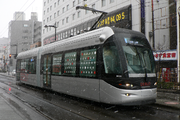
Tramway systems were well established in the Asian region at the start of the 20th century, but started a steady decline during the mid to late 30s. The 1960s marked the end of its dominance in public transportation with most major systems closed and the equipment and rails sold for scrap; however, some extensive original lines still remain in service in Hong Kong and Japan. In recent years there has been renewed interest in the tram with modern systems being built in South Korea, Japan, and the Philippines.
The first Japanese tram line was inaugurated in 1895 as the Kyoto Electric Railroad. The tram reached its zenith in 1932 when 82 rail companies operated 1,479 kilometers of track in 65 cities. The tram declined in popularity through the remaining years of the 30s, a trend that was accelerated by the damages of the War and continued through the Occupation and rebuilding years. During the 1960s many of the remaining operational tramways were shut down and dismantled in favor of auto, bus, and rapid rail service; however, when one compares the number of operational lines that survived this era to their American counterparts, they can be defined as quite extensive.
Europe
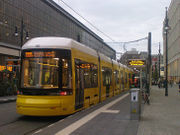
In many European cities much tramway infrastructure was lost in the mid-20th century, though not always on the same scale as in other parts of the world such as North America. Most of Eastern Europe retained tramway systems until recent years but some cities are now reconsidering their transport priorities. In contrast, some Western European cities are rehabilitating, upgrading, expanding and reconstructing their old tramway lines. Many Western European towns and cities are also building new tramway lines.
North America

In North America trams are generally known as streetcars or trolleys; the term tram is more likely to be understood as a tourist trolley, an aerial tramway, or a people-mover.
In some North American cities, streetcar lines were largely torn up in the mid-20th century for a variety of financial, technological and social reasons. (See also the Great American Streetcar Scandal.) Exceptions include New Orleans, Tampa, Newark, Seattle, Philadelphia (with a much smaller network than once had existed), and San Francisco. American cities, such as Tacoma, Washington, D.C., Portland, Seattle, and Detroit are beginning to rebuild or add streetcar systems. Pittsburgh kept most of its streetcar system serving the city and many suburbs until January 27, 1967, making it the longest-lasting large-network U.S. streetcar system. In the late 20th century, several cities installed light rail systems, in part along the same corridor as the old streetcars.
Toronto currently has the largest streetcar system in the Americas in terms of track length and ridership, operated by the Toronto Transit Commission. It is the only streetcar system existing in Canada, not including the light rail systems that some Canadian cities currently operate. Toronto's system uses Canadian Light Rail Vehicles and Articulated Light Rail Vehicles, after a history of using PCCs, Peter Witt cars, and horse-drawn carriages. The system is currently proposing to replace its current fleet with Bombardier's Flexity Outlook models, which is also used in some European tram systems. Streetcars once existed in Edmonton and Calgary, but both cities have since converted their systems to support light rail vehicles instead. Some have restored their old streetcars and run them as a heritage feature for tourists, like the Vancouver Downtown Historic Railway.
Oceania

In Australasia, trams are used extensively only in Melbourne, and to a lesser extent, Adelaide, all other major cities having largely dismantled their networks by the 1970s. Sydney reintroduced its tram in 1997 as a modern system (Metro Light Rail), while Ballarat, Bendigo, Christchurch and Perth reintroduced their trams as heritage systems.
A distinctive feature of many Australasian trams was the early use of a lowered central section between bogies (wheel-sets). This was intended to make passenger access easier, by reducing the number of steps required to reach the inside of the vehicle. It is believed that the design first originated in Christchurch in the first decade of the 20th century. Cars with this design feature were frequently referred to as "drop-centres".
The trams made by Boon & Co of Christchurch, New Zealand in 1906-07 for use in Christchurch may have been the first with this feature; they were referred to as drop-centres or Boon cars. Trams for Christchurch and Wellington built in the 1920s with an enclosed section at each end and an open-sided middle section were also known as Boon cars, but did not have the drop-centre.
South America
.jpg)
Buenos Aires in Argentina had once one of the most extensive tramway networks in the world with over 857 km (535 mi) of track, most of it dismantled during the 1960s in favor of bus transportation. Now slowly coming back, the 2 km Puerto Madero Tramway running in the Puerto Madero district is spearheading the move with extensions to Retiro station and La Boca in the planning stages. Another line, the PreMetro line E2 system feeding the Line E of the Buenos Aires Subway has been operating for the past few years on the outskirts of Buenos Aires, and a unique leisure "Tren de la Costa", an artery that stretches for 15 kilometres by the River Plate, from Olivos to the village of Tigre has also been running in Buenos Aires.
Also in Argentina, in the city Mendoza, a new tramway line is in construction, the Metrotranvía of Mendoza, which will have a route of 12.5 km and will link five districts of the Greater Mendoza conurbation. The opening of the system is scheduled for 2011. Also in Medellín, Colombia there´s a tram under construction and the opening schedule is for December 2011. [28]
Pros and cons of tram systems
All transit services involve a trade-off between speed and frequency of stops. Services that stop frequently have a lower overall speed, and are therefore less attractive for longer trips. Metros, light rail, monorail, and bus rapid transit are all forms of rapid transit — which generally signifies high speed and widely spaced stops. Trams are often used as a form of local transit, making frequent stops. Thus, the most meaningful comparison of advantages and disadvantages is with other forms of local transit, primarily the local bus.
Advantages
- Unlike buses, but like trolleybuses, (electric) trams give off no exhaust emissions at point of use. Compared to motorbuses the noise of trams is generally perceived to be less disturbing.[29] However, the use of solid axles with wheels fixed to them causes slippage between wheels and tracks when negotiating curves. This produces a characteristic loud, high frequency noise often referred to as a "squeal."
- They can use overhead wire set to be shared with trolleybuses (a three wire system).
- Trams can adapt to the number of passengers by adding more cars during rush hour (and removing them during off-peak hours). No additional driver is then required for the trip in comparison to buses.
- In general, trams provide a higher capacity service than buses.
- Multiple entrances allow trams to load faster than suburban coaches, which tend to have a single entrance. This, combined with swifter acceleration and braking, lets trams maintain higher overall speeds than buses, if congestion allows.[30]
- The trams' stops in the street are easily accessible - unlike stations of subways and commuter railways placed underground (with several escalators, stairways etc.) or in the outskirts of the city center.
- Rights-of-way for trams are narrower than for buses. This saves valuable space in cities with high population densities and/or narrow streets.
- Trams can trackshare with mainline railways, servicing smaller towns without requiring special track as in Stadtbahn Karlsruhe - and at greater speed than buses.
- Passenger comfort is normally superior to buses because of controlled acceleration and braking and curve easement. Rail transport such as used by trams provides a smoother ride than road use by buses.
- Because the tracks are visible, it is easy for potential riders to know where the routes are.
- Vehicles run more efficiently and overall operating costs are lower.[31]
- Trams can run on renewable electricity without the need for very expensive and short life batteries.[32]
- Consistent market research and experience over the last 50 years in Europe and North America shows that car commuters are willing to transfer some trips to rail-based public transport but not to buses. Typically light rail systems attract between 30 and 40% of their patronage from former car trips. Rapid transit bus systems attract less than 5% of trips from cars, less than the variability of traffic.[32]
Disadvantages
- Tram infrastructure (such as island platforms) occupies urban space at ground-level, sometimes to the exclusion of other users, including cars.
- The capital cost is higher than for buses, even if a tramcar usually have a much higher lifetime than a bus.
- Trams can cause speed reduction for other transport modes (buses, cars) when stops in the middle of the road do not have pedestrian refuges, as in such configurations other traffic cannot pass whilst passengers alight or board the tram.
- When operated in mixed traffic, trams are more likely to be delayed by disruptions in their lane. Buses, by contrast, can sometimes manoeuver around obstacles. Opinions differ on whether the deference that drivers show to trams — a cultural issue that varies by country — is sufficient to counteract this disadvantage.
- Tram tracks can be hazardous for cyclists, as bikes, particularly those with narrow tyres, may get their wheels caught in the track grooves. It is possible to close the grooves of the tracks on critical sections by rubber profiles that are pressed down by the wheelflanges of the passing tram but that cannot be lowered by the weight of a cyclist. If not well-maintained, however, these lose their effectiveness over time.
- Steel wheel trams are noisier than rubber-wheeled buses or trolleybuses when cornering if there are no additional measures taken (e.g. greasing wheel flanges, which is standard in new-built systems). Tram wheels are fixed onto axles so they have to rotate together, but going around curves, one wheel or the other has to slip, and that causes loud unpleasant squeals. A related improvement is rubber isolation between the wheel disc and the rim, as used on Boston (Massachusetts, USA) Green Line 3400 and 3600 series cars. These cars are much quieter than those with solid metal wheels. (This construction requires a flexible cable to electrically connect the tire to the wheel body.)
- Light rail vehicles are often heavier per passenger carried than heavy rail and monorail cars, as they are designed with higher durability (which means more mass) to survive collisions, since they cannot swerve to avoid oncoming objects in emergencies.
- The opening of new tram and light rail systems has sometimes been accompanied by a marked increase in car accidents, as a result of drivers' unfamiliarity with the physics and geometry of trams.[33] Though such increases may be temporary, long-term conflicts between motorists and light rail operations can be alleviated by segregating their respective rights-of-way and installing appropriate signage and warning systems.[34]
- Rail transport can expose neighbouring populations to moderate levels of low-frequency noise. However, transportation planners use noise mitigation strategies to minimize these effects.[35] Most of all, the potential for decreased private motor vehicle operations along the trolley's service line because of the service provision could result in lower ambient noise levels than without.
- In the event of a breakdown or accident, or even roadworks and maintenance, a whole section of the tram network can be blocked. Buses and trolleybuses can often get past minor blockages, although trolleybuses are restricted by how far they can go from the wires. Conventional buses can divert around major blockages as well, as can most modern trolleybuses that are fitted with auxiliary engines or traction batteries. The tram blockage problem can be mitigated by providing regular crossovers so a tram can run on the opposite line to pass a blockage, although this can be more difficult when running on road sections shared with other road users. On extensive networks diversionary routes may be available depending on the location of the blockage. Breakdown related problems can be reduced by minimising the situations where a tram would be stuck on route, as well as making it as simple as possible for another tram to rescue a failed one.
 Trams in Helsinki |
 Tram tracks can be hazardous to cyclists |
 Tram accident in Amsterdam |
Hong Kong Tramways passing each other at Central. |
|
Solaris Tramino on motorshow. |
 Tramways on ice of the River Neva in Saint Petersburg |
 The San Diego Trolley going through downtown. |
Trams in Calcutta |
In other media
In literature
One of the earliest literary references to trams occurs on the second page of Henry James's novel The Europeans:
- From time to time a strange vehicle drew near to the place where they stood—such a vehicle as the lady at the window, in spite of a considerable acquaintance with human inventions, had never seen before: a huge, low, omnibus, painted in brilliant colours, and decorated apparently with jingling bells, attached to a species of groove in the pavement, through which it was dragged, with a great deal of rumbling, bouncing, and scratching, by a couple of remarkably small horses.
Published in 1878, the novel is set in the 1840s, though horse trams were not introduced in Boston till the 1850s. Note how the tram's efficiency surprises the European visitor; how two "remarkably small" horses sufficed to draw the "huge" tramcar.
James also makes comical reference to the novelty and excitement of trams in Portrait of a Lady (1881):
- Henrietta Stackpole was struck with the fact that ancient Rome had been paved a good deal like New York, and even found an analogy between the deep chariot-ruts traceable in the antique street and the overjangled iron grooves which express the intensity of American life. (page 313 of Penguin edition.)
A quarter of a century later, Joseph Conrad described Amsterdam's trams in chapter 14 of The Mirror of the Sea (1906): From afar at the end of Tsar Peter Straat, issued in the frosty air the tinkle of bells of the horse tramcars, appearing and disappearing in the opening between the buildings, like little toy carriages harnessed with toy horses and played with by people that appeared no bigger than children.
Danzig trams figure extensively in the early stages of Günter Grass's Die Blechtrommel (The Tin Drum). In the last chapter the novel's hero Oskar Matzerath and his friend Gottfried von Vittlar steal a tram late at night from outside Unterrath depot on the northern edge of Düsseldorf.
It is a surreal journey. Von Vittlar drives the tram through the night, south to Flingern and Haniel and then east to the suburb of Gerresheim. Meanwhile, inside, Matzerath tries to rescue the half-blind Victor Weluhn (who had escaped from the siege of the Polish post office in Danzig at the beginning of the book and of the war) from his two green-hatted would-be executioners. Mazerath deposits his briefcase, which contains Sister Dorotea's severed ring finger in a preserving jar, on the dashboard "where professional motorman put their lunchboxes". They leave the tram at the terminus and the executioners tie Weluhn to a tree in von Vittlar's mother's garden and prepare to machine-gun him. But Matzerath drums, Weluhn sings, and together they conjure up the Polish cavalry, who spirit both victim and executioners away. Matzerath asks von Vittlar to take his briefcase in the tram to the police HQ in the Fürstenwall, which he does.
The latter part of this route is today served by tram route 703 terminating at Gerresheim Stadtbahn station ("by the glassworks" as Grass notes, referring to the famous glass factory).[36]
In his 1967 spy thriller An Expensive Place to Die, Len Deighton misidentifies the Flemish coast tram: "The red glow of Ostend is nearer now and yellow trains rattle alongside the motor road and over the bridge by the Royal Yacht Club..."[37] [Chapter 38, page 198 of the Companion Book Club edition.]
In popular culture
- The Rev W. Awdry wrote about GER Class C53 called Toby the Tram Engine, which starred his The Railway Series with his faithful coach, Henrietta.
- A Streetcar Named Desire (play)
- A Streetcar Named Desire (1951 film)
- The children's TV show Mister Rogers’ Neighborhood featured a trolley.
- The central plot of the film Who Framed Roger Rabbit involves the Judge Doom, the villain, dismantling the streetcars of Los Angeles.
- "The Trolley Song" in the film Meet Me in St. Louis received an Academy Award nomination.
- The 1944 World Series was also known as the "Streetcar Series".
- Malcolm (film), an Australian film about a tram enthusiast who uses his inventions to pull off a bank heist.
- Luis Buñuel filmed La Ilusión viaja en tranvía [38] (English: Illusion Travels by Streetcar) in Mexico in 1953.
- In Akira Kurosawa's film Dodesukaden a mentally ill boy pretends to be a tram conductor.
- The Stompin' Tom Connors song "To It And At It" mentions a man who "can't afford the train, he's sittin' on a streetcar, but he's eastbound just the same."
- The predominance of trams (trolleys) gave rise to the disparaging term trolley dodger for residents of the borough of Brooklyn in New York City. That term, shortened to "Dodger" became the nickname for the Brooklyn Dodgers (now the Los Angeles Dodgers).
- Jens Lekman has a song titled "Tram #7 to Heaven", a reference to line 7 of the Gothenburg tram which passes through his native borough of Kortedala.
- The band Beirut has a song titled "Fountains and Tramways" on the EP Pompeii.
- The Elephant Will Never Forget, an 11-minute film made in 1953 by British Transport Films to celebrate the London tram network at the time of the last few days of its operation.
- A W-class tram was used at the opening ceremony of the 2006 Commonwealth Games in Melbourne.
- 2009 Thomas Haggerty composed and produced 'Tram' generations 1, 2 and 3 for the popular group TRAM.
- A collaboration between John Ward and Elizabeth Harrod: "a great tram."

In scale modelling
Model trams are popular in HO scale (1:87) and O scale (1:48 in the US and generally 1:43 in Europe and Asia). They are typically powered and will accept plastic figures inside. Common manufacturers are Roco and Lima, with many custom models being made as well. The German firm Hödl [39] and the Austrian Halling[40] specialize in 1:87 scale.[41]
In the US, Bachmann Industries is a mass supplier of HO trams and kits. Bowser Manufacturing has produced white metal models for over 50 years.[42] There are many boutique vendors offering limited run epoxy and wood models. At the high end are highly detailed brass models which are usually imported from Japan or Korea and can cost in excess of $500. Many of these run on 16.5 mm gauge track, which is correct for the representation of 4 ft 8 1⁄2 in (1,435 mm) (standard gauge) in HO scale as in US and Japan, but incorrect in 4 mm (1:76.2) scale, as it represents 4 ft 1½ in (1,257 mm). This scale/gauge hybrid is called OO scale. O scale trams are also very popular among tram modellers because the increased size allows for more detail and easier crafting of overhead wiring. In the US these models are usually purchased in epoxy or wood kits and some as brass models. The Saint Petersburg Tram Company [43] produces highly detailed polyurethane non-powered O Scale models from around the world which can easily be powered by trucks from vendors like Q-Car.[44]
In the US, one of the best resources for model tram enthusiasts is the East Penn Traction Club of Philadelphia.[45]
It is thought that the first example of a working model tramcar in the UK built by an amateur for fun was in 1929, when Frank E. Wilson created a replica of London County Council Tramways E class car 444 in 1:16 scale, which he demonstrated at an early Model Engineer Exhibition. Another of his models was London E/1 1800, which was the only tramway exhibit in the Faraday Memorial Exhibition of 1931. Together with likeminded friends, Frank Wilson went on to found the Tramway & Light Railway Society [46] in 1938, establishing tramway modelling as a hobby.
Types
|
|
|
Regional
- Trams in Africa
- Trams in Asia
- Trams in Australia
- Trams in Europe
- Trams in New Zealand
- Streetcars in North America
- Trams in South America
Modern city networks
Africa
 Egypt: Alexandria
Egypt: Alexandria
Asia
Europe
 Belarus : Minsk
Belarus : Minsk Bulgaria : Sofia
Bulgaria : Sofia.svg.png) Belgium : De Panne - Knokke-Heist - Brussels - Ghent - Antwerp - Charleroi
Belgium : De Panne - Knokke-Heist - Brussels - Ghent - Antwerp - Charleroi Bosnia and Herzegovina : Sarajevo
Bosnia and Herzegovina : Sarajevo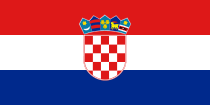 Croatia : Osijek - Zagreb
Croatia : Osijek - Zagreb Czech Republic : Prague - Liberec - Liberec-Jablonec - Most - Litvínov - Olomouc - Ostrava - Plzeň - Brno, planned in Havířov and Těšín
Czech Republic : Prague - Liberec - Liberec-Jablonec - Most - Litvínov - Olomouc - Ostrava - Plzeň - Brno, planned in Havířov and Těšín Finland : Helsinki - Turku
Finland : Helsinki - Turku France : Bordeaux - Grenoble - Lille - Lyon - Marseille - Montpellier - Mulhouse - Nantes - Nice - Paris - Rouen - Saint-Étienne - Strasbourg - Valenciennes
France : Bordeaux - Grenoble - Lille - Lyon - Marseille - Montpellier - Mulhouse - Nantes - Nice - Paris - Rouen - Saint-Étienne - Strasbourg - Valenciennes Germany : Berlin - Bremen - Dresden - Düsseldorf - Frankfurt am Main - Freiburg - Kassel
Germany : Berlin - Bremen - Dresden - Düsseldorf - Frankfurt am Main - Freiburg - Kassel Greece : Athens
Greece : Athens Ireland : Dublin
Ireland : Dublin Italy : Milan, Turin, Rome, Florence
Italy : Milan, Turin, Rome, Florence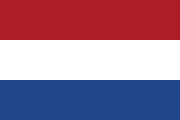 Netherlands : Amsterdam,[47] Rotterdam,[48] Den Haag,[49] Utrecht[50]
Netherlands : Amsterdam,[47] Rotterdam,[48] Den Haag,[49] Utrecht[50] Norway : Oslo
Norway : Oslo Poland : Warsaw, Poznań, Łódź, Wrocław, Gorzów Wielkopolski, Bydgoszcz, Kraków, Silesian Interurbans, Szczecin , Elbląg, Gdańsk, Toruń, Grudziądz, Bydgoszcz
Poland : Warsaw, Poznań, Łódź, Wrocław, Gorzów Wielkopolski, Bydgoszcz, Kraków, Silesian Interurbans, Szczecin , Elbląg, Gdańsk, Toruń, Grudziądz, Bydgoszcz Romania : Urban Tramway Systems in Romania
Romania : Urban Tramway Systems in Romania Russia : St Petersburg - Volgograd
Russia : St Petersburg - Volgograd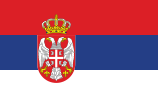 Serbia : Belgrade
Serbia : Belgrade Slovakia : Košice, Bratislava
Slovakia : Košice, Bratislava Spain : Alicante - Barcelona - Bilbao - Madrid - Seville - Valencia
Spain : Alicante - Barcelona - Bilbao - Madrid - Seville - Valencia Sweden : Gothenburg - Norrköping - Stockholm
Sweden : Gothenburg - Norrköping - Stockholm Switzerland : Basel - Zürich
Switzerland : Basel - Zürich United Kingdom : Blackpool - Edinburgh - London - Manchester - Midlands - Nottingham - Sheffield
United Kingdom : Blackpool - Edinburgh - London - Manchester - Midlands - Nottingham - Sheffield
North America
 Canada : Toronto
Canada : Toronto United States : Baltimore - Boston - Dallas - Denver - Philadelphia - Portland, Oregon - Kenosha - San Diego - Seattle - Tacoma, Washington - Washington, D.C.
United States : Baltimore - Boston - Dallas - Denver - Philadelphia - Portland, Oregon - Kenosha - San Diego - Seattle - Tacoma, Washington - Washington, D.C.
Oceania
South America
 Argentina : Buenos Aires
Argentina : Buenos Aires Venezuela : Valencia
Venezuela : Valencia
See also
|
|
|
References
- ↑ London Passenger Transport Board: Annual Report, 1938
- ↑ http://www.shore-line.org/CSL.html
- ↑ Jeffrey Spivak: Streetcars are back from Landscape Architecture Department, UC Davis. Retrieved 10 February 2009. ucdavis.edu
- ↑ (French) Musée des Transports Urbains - Histoire., amtuir.org Retrieved 11 February 2009.
- ↑ Online Etymology Dictionary, etymonline.com. Retrieved 4 April 2009.
- ↑ Robert C. Post: Urban Mass Transit, p.43, from Google Books.com. Retrieved 13 February 2009.
- ↑ Middleton, William D. (1967). The Time of the Trolley, p. 60. Milwaukee: Kalmbach Publishing. ISBN 0-89024-013-2.
- ↑ The Mumbles Train from Welcome to Wales., welshwales.co.uk. Retrieved 11 February 2009.
- ↑ Manhattan's Lost Streetcars by Stephen L. Meyers from nyctransitforums.com Retrieved 11 February 2009.
- ↑ Bellis, Mary. "History of Streetcars and Cable Cars". inventors.about.com. http://inventors.about.com/library/inventors/blstreetcars.htm. Retrieved 2007-01-10.
- ↑ Beograd.org Retrieved 13 September 2009.
- ↑ Trams of Hungary. Retrieved 11 February 2009.
- ↑ Transport History in Bucharest. Retrieved 11 February 2009.
- ↑ Sarajevo through history. Retrieved 11 February 2009.
- ↑ American Public Transportation Association. "Milestones in U.S. Public Transportation History". http://www.apta.com/research/stats/history/mileston.cfm. Retrieved 2008-12-18.
- ↑ Wood, E. Thomas. "Nashville now and then: From here to there". http://www.nashvillepost.com/news/2007/4/27/nashville_now_and_then_from_here_to_there. Retrieved 2007-08-07.
- ↑ Citytram
- ↑ Yarratrams Newsletter No 8. Retrieved 12 February 2009.
- ↑ Draemmli.info (German)
- ↑ Hungarian Wikipedia (Hungarian)
- ↑ Avenio, Then new generation trams from Siemens, Transportation.siemens.com
- ↑ Weymouth Harbour Tramway
- ↑ George G. Wynne: 'CarGo Tram' Provides Freight Service on Dresden's Light Rail Tracks, apta.com. Retrieved 12 February 2009.
- ↑ Clean and efficient freight tram delivers goods – Amsterdam, NL, eukn.org. Retrieved 12 February 2009.
- ↑ Samenwest 5 December 2006, NOS3 television news 7 March 2007, Amsterdams Stadblad 4 June 2008
- ↑ Giornale della Reale società italiana d'igiene, Seduta del 5 febbrajo 1882, Archive.org
- ↑ (Italian) Tramditorino.it
- ↑ Metrotranvia deal signed, Railway Gazette International, railwaygazette.com - Accessed 22 June 2009
- ↑ Pros and cons of tram systems, spiritus-temporis.com. Retrieved 13 February 2009.
- ↑ Streetcar and Local Bus Comparative Review from Vancouver City, vancouver.ca. Retrieved 13 February 2009.
- ↑ Why are trams different from buses from Trams for Bath. Retrieved 13 February 2009.
- ↑ 32.0 32.1 Sustainable Light Rail - professor Lewis Lesley. Claverton Energy Group Conference, Bath October 2008, claverton-energy.com
- ↑ Charles S. McCaleb, Rails, Roads & Runways: The 20-Year Saga of Santa Clara County's Transportation Agency, (San Jose: Santa Clara County Transportation Agency, 1994), 67. Besides recounting statistics and anecdotes, this source also reprints a San Jose Mercury News cartoon of one such accident, in which a bemused tow truck driver quips, "Dang! Rod Diridon was right! The trolley does reduce the number of vehicles on the road!"
- ↑ Transit Cooperative Research Program (TCRP) Report 69: Light Rail Service: Pedestrian and Vehicular Safety, Transportation Research Board TRB.org
- ↑ Transit Cooperative Research Program (TCRP) Report 23: Wheel/Rail Noise Control Manual, Transportation Research Board, TRB.org
- ↑ The chapter Die letzte Straßenbahn oder Anbetung eines Weckglases (The last tram or Adoration of a Preserving Jar). See page 584 of the 1959 Büchergilde Gutenberg German edition and page 571 of the 1961 Secker & Warburg edition, translated into English by Ralph Manheim
- ↑ Ryco.be
- ↑ IMDb.com
- ↑ Hödl, horlf-linir8.de
- ↑ Halling.at
- ↑ (German) Marktübersicht Straßenbahnmodelle, from Strassenbahnfreunden-Hemer.de
- ↑ Bowser - Company History 1961 to Present. bowser-trains.com Retrieved 14 February 2009.
- ↑ Saint Petersburg Tram Company, sptc.spb.ru
- ↑ Q-Car, qcarcompany.com. retrieved 2 September 2009.
- ↑ East Penn Traction Club, eastpenn.org. Retrieved 14 February 2009.
- ↑ Tramway & Light Railway Society, tramwayinfo.com
- ↑ Amsterdamse tram
- ↑ Rotterdamse tram
- ↑ Haagse tram
- ↑ Utrechtse sneltram
External links
- 'Tramway' (article in the 1911 Britannica), 1911encyclopedia.org
- Compressed Air Trams at Tramway & Light Railway Society (UK), tramwayinfo.com
- What is a streetcar? at American Public Transit Association, apta.com
- Tram Travels (tram enthusiast website providing large number of links and photos), sporvognsrejser.dk
- Tram Guide in EVTransPortal, evtransportal.com.
- (Romanian) Tram Guide in Bucharest and Romania.
Further reading
- Accattatis, Antonio. 2007. "Linee tranviarie a Torino" (ISBN 978-88-87911-78-7). Firenze: Phasar Edizioni.
- Arrivetz, Jean. 1956. "Les Tramways Français" (No ISBN). Lyon: Editions Omni-Presse.
- Bett, W. C., and J. C. Gillam. 1962. "Great British Tramway Networks (4th Edition)", ISBN 0-900433-03-5. London: Light Railway Transport League.
- Blower, James M., and Robert S. Korach. 1966. "The NOT&L Story" (CERA Bulletin 109) (No ISBN). Chicago: Central Electric Railfans' Association.
- Brimson, Samuel. 1983. "The Tramways of Australia" (ISBN 0-949825-01-8). Sydney: Dreamweaver Books.
- Brinson, Carroll. 1977. "Jackson: A Special Kind of Place" (LCCN 77-081145) (No ISBN). Jackson, Mississippi: City of Jackson.
- Buckley, R. J. 1984. "Tramways and Light Railways of Switzerland and Austria" (ISBN 0-900433-96-5). Milton Keynes, UK: Light Rail Transit Association.
- Canfield, Joseph M. (ed.) 1965. "Electric Railways of Northeastern Ohio" (CERA Bulletin 108) (No ISBN). Chicago: Central Electric Railfans' Association.
- Canfield, Joseph M. (ed.) 1968. "West Penn Traction" (CERA Bulletin 110) (No ISBN). Chicago: Central Electric Railfans' Association.
- Canfield, Joseph M. 1969. "Badger Traction" (CERA Bulletin 111) (No ISBN). Chicago: Central Electric Railfans' Association.
- Canfield, Joseph M. 1972. "TM: The Milwaukee Electric Railway & Light Company" (CERA Bulletin) (No ISBN). Chicago: Central Electric Railfans' Association.
- Carlson, Norman (ed.), with Robert J. Levis (Research Coordinator). 1975. "Iowa Trolleys" (CERA Bulletin 114) (No ISBN). Chicago: Central Electric Railfans' Association.
- Chandler, Allison. 1963. "Trolley Through the Countryside" (No ISBN). Denver: Sage Books.
- Chandler, Allison, and Stephen D. Maguire, with Mac Sebree. 1980. "When Oklahoma Took The Trolley" (Interurbans Special 71) (ISBN 0-916374-35-1). Glendale (CA), US: Interurban Press.
- Charlton, E. Harper. 1955. "Street Railways of New Orleans" (Interurbans Specian No. 17, No ISBN). Los Angeles: Interurbans.
- Cox, Harold E. 1991. "Diamond State Trolleys - Electric Railways of Delaware." Forty Fort (PA), US: Harold E. Cox.
- Davies, W. K. J. 1986. "100 years of the Belgian vicinal: SNCV/NMVB, 1885-1985 : a century of secondary rail transport in Belgium" (ISBN 0-900433-97-3). Broxbourne, UK: Light Rail Transit Association.
- Dyer, Peter, and Peter Hodge. 1988. "Cane Train: The Sugar-Cane Railways of Fiji" (ISBN 0-908573-50-2). Wellington: New Zealand Railway and Locomotive Society Inc.
- "Electric Railways of Indiana Part II, The" (CERA Bulletin 102) (No ISBN). 1958. Chicago: Central Electric Railfans' Association.
- "Electric Railways of Michigan, The" (CERA Bulletin 103) (No ISBN). 1959. Chicago: Central Electric Railfans' Association.
- Fetters, Thomas. 1978. "Palmetto Traction: Electric Railways of South Carolina" (No ISBN) Forty Fort (PA), US: Harold E. Cox.
- Fletcher, Ken. 1995. "Centennial State Trolleys: The Life and Times of Colorado Streetcars" (ISBN 0-918654-51-3). Golden (CO), US: Colorado Railroad Museum.
- Gragt, Frits van der. 1968. "Europe's Greatest Tramway Network" (No ISBN). Leiden, Netherlands: E.J. Brill.
- Hamm, Edward. 1992. "The Public Service Trolley Lines in New Jersey" (ISBN 0-933449-12-7). Poli (IL), US: Transportation Trains.
- Harper, James P. 1953. "Electric Railways of Wisconsin" (CERA Bulletin 97) (No ISBN). Chicago: Central Electric Railfans' Association.
- Hennick, Louis C., and E. Harper Charlton. 1999. "Street Railways of Louisiana" (ISBN 1-56554-564-8). Gretna (LA), US: Pelican.
- Hilton, George W. 1997. "The Cable Car in America: A New Treatise upon Cable or Rope Traction As Applied to the Working of Street and Other Railways", Revised Edition (ISBN 0-8047-3051-2). Stanford (CA), US: Stanford University Press.
- Howarth, W. Des. 1971. "Tramway Systems of Southern Africa" (No ISBN). Johannesburg: published by the author.
- Janssen, William C. 1954. "The Illinois Traction System" (CERA Bulletin 98) (No ISBN). Chicago: Central Electric Railfans' Association.
- Keenan, David. 1979. "Tramways of Sydney" (ISBN 0-909338-02-7). Sans Souci (NSW), Australia: Transit Press.
- King, B. R., and J. H. Price. 1995. "The Tramways of Portugal (4th Edition)" (ISBN 0-948106-19-0). London: Light Rail Transit Association.
- Krambles, George. 1952. "Electric Railways of Ohio" (CERA Bulletin 96) (No ISBN). Chicago: Central Electric Railfans' Association.
- Kramer, Frederick A., with Ed Wadhams. "Connecticut Company's Streetcars" (ISBN 0-911868-82-8). Newton (NJ), US: Carstens.
- MacCowan, Ian. 1992. "The Tramways of New South Wales" (ISBN 0-949600-25-3). Oakleigh (Victoria) Australia: published by the author.
- McCarthy, Ken. 1983. "Steaming Down Argent Street: A History of the Broken Hill Steam Tramways 1902-1926" (ISBN 0-909372-13-6). Sutherland (NSW), Australia: The Sydney Tramway Museum.
- Middleton, William D. 1967. The Time of the Trolley (ISBN 0-89024-013-2). Milwaukee (WI), US: Kalmbach Publishing.
- Misek, Frank J. 1956. "The Electric Railways of Iowa" (CERA Bulletin 100) (No ISBN). Chicago: Central Electric Railfans' Association.
- Misek, Frank J. (ed.). 1958. "The Electric Railways of Indiana Part I" (CERA Bulletin 101) (No ISBN). Chicago: Central Electric Railfans' Association.
- Misek, Frank J. (ed.). 1960. "The Electric Railways of Indiana Part III" (CERA Bulletin 104) (No ISBN). Chicago: Central Electric Railfans' Association.
- Molloy, D. Scott. 1998. "All Aboard: The History Of Mass Transportation In Rhode Island" (ISBN 0-7524-1256-6). Mount Pleasant (SC), US: Arcadia Publishing.
- Morrison, Allen. 1989. "The Tramways of Brazil - A 130-Year Survey" (ISBN 0-9622348-1-8) [1]. New York: Bonde Press.
- Morrison, Allen. 1992. "The Tramways of Chile - 1858 - 1978" (ISBN 0-9622348-2-6) [2]. New York: Bonde Press.
- Morrison, Allen. 1996. "Latin America by Streetcar: A Pictorial Survey of Urban Rail Transport South of the U.S.A." (ISBN 0-9622348-3-4). New York: Bonde Press.
- Myers, Rex. 1970. "Montana's Trolleys: Book 1, Helena" (No ISBN). Los Angeles: Interurbans.
- Meyers, Stephen L.: Manhattan's lost streetcars, Arcadia, 2005. ISBN 0-7385-3884-1
- Nye, David E.: Electrifying America : social meanings of a new technology, 1880-1940, MIT Press, Cambridge, Massachusetts c1990. ISBN 0-262-14048-9
- Olson, Russell L. 1976. "The Electric Railways of Minnesota" (No ISBN). Hopkins (MN), US: Minnesota Transportation Museum.
- Orr, Richard. 1996 O&CB: Streetcars of Omaha and Council Bluffs (ISBN 0-9653505-0-9). Omaha: published by the author.
- Pabst, Martin. 1989. "Tram & Trolley in Africa" (ISBN 3-88490-152-4). Krefeld: Röhr Verlag GMBH.
- Peschkes, Robert. "World Gazetteer of Tram, Trolleybus, and Rapid Transit Systems."
- Part One, Latin America (ISBN 1-898319-02-2). 1980. Exeter, UK: Quail Map Company.
- Part Two, Asia+USSR / Africa / Australia (ISBN 0-948619-00-7). 1987. London: Rapid Transit Publications.
- Part Three, Europe (ISBN 0-948619-01-5). 1993. London: Rapid Transit Publications.
- Part Four, North America (ISBN 0-948619-06-6). 1998. London: Rapid Transit Publications.
- Reifschneider, Felix E. 1947. "Toonervilles of the Empire State" (No ISBN). Orlando (FL), U.S.: published by the author.
- Reifschneider, Felix E. 1948. "Trolley Lines of the Empire State" (No ISBN). Orlando (FL), U.S.: published by the author.
- Röhr, Gustav. 1986. "Schmalspurparadies Schweiz", Band 1: Berner Oberland, Jura, Westschweiz, Genfer See, Wallis (ISBN 3-921679-38-9). Aachen: Schweers + Wall.
- Rowsome, Frank; Stephan McGuire, tech. ed. (1956). A Trolley Car Treasury: A Century of American Streetcars—Horsecars, Cable Cars, Interurbans, and Trolleys. New York: McGraw-Hill.
- Schramm, Jack E., and William H. Henning. 1978. "Detroit's Street Railways, Volume I" (CERA Bulletin 117) (No ISBN). Chicago: Central Electric Railfans' Association.
- Schramm, Jack E., William H. Henning and Thomas J. Devorman. 1980. "Detroit's Street Railways, Volume II" (CERA Bulletin 120) (No ISBN). Chicago: Central Electric Railfans' Association.
- Schramm, Jack E., William H. Henning and Andrews, Richard R. 1984. "Detroit's Street Railways, Volume III: When Eastern Michigan Rode the Rails" (CERA Bulletin 123) (No ISBN). Chicago: Central Electric Railfans' Association.
- Schweers, Hans. 1988. "Schmalspurparadies Schweiz", Band 2: Nordostschweiz, Mittelland, Zentralschweiz, Graubünden, Tessin (ISBN 3-921679-46-X). Aachen: Schweers + Wall.
- "Smaller Electric Railways of Illinois, The" (CERA Bulletin 99) (No ISBN). 1955. Chicago: Central Electric Railfans' Association.
- Stewart, Graham. 1985. "When Trams Were Trumps in New Zealand" (OCLC 12723934). Wellington: Grantham House Publishing.
- Stewart, Graham. 1993 "The End of the Penny Section" (revised and enlarged edition) (ISBN 1-86934-037-X). Wellington: Grantham House Publishing.
- "Straßenbahnatlas ehem. Sowjetunion / Tramway Atlas of the former USSR" (ISBN 3-926524-15-4). 1996. Berlin: Arbeitsgemeinschaft Blickpunkt Straßenbahn, in conjunction with Light Rail Transit Association, London.
- "Straßenbahnatlas Rumänien" (compiled by Andreas Günter, Sergei Tarknov and Christian Blank; ISBN 3-926524-23-5). 2004. Berlin: Arbeitsgemeinschaft Blickpunkt Straßenbahn.
- Swett, Ira, with Fred Fellow. 1954. "Interurbans of Utah" (Interurbans Special 15) (No ISBN). Los Angeles: Interurbans.
- Swett, Ira. 1970. "Montana's Trolleys 2: Butte, Anaconda, BAP" (Interurbans Special 50) (No ISBN). Los Angeles: Interurbans.
- Swett, Ira. 1970. "Montana's Trolleys - III: Billings, Bozeman, Great Falls, Missoula, Proposed Lines, The Milwaukee Road (Interurbans Special 51) (No ISBN). Los Angeles: Interurbans.
- "Tramway & Light Railway Atlas - Germany 1996" (ISBN 0-948106-18-2). 1995. Berlin: Arbeitsgemeinschaft Blickpunkt Straßenbahn, in conjunction with Light Rail Transit Association, London.
- Turner, Kevin. 1996. "The Directory of British Tramways: Every Passenger-Carrying Tramway, Past and Present" (ISBN 1-85260-549-9). Somerset, UK: Haynes.
- Waller, Michael H., and Peter Walker. 1992. "British & Irish Tramway Systems since 1945" (ISBN 0-7110-1989-4). Shepperton (Surrey), UK: Ian Allan Ltd.
|
||||||||||||||||||||||||||
